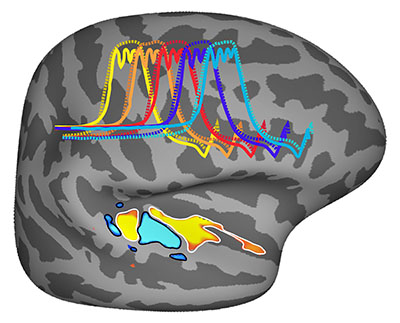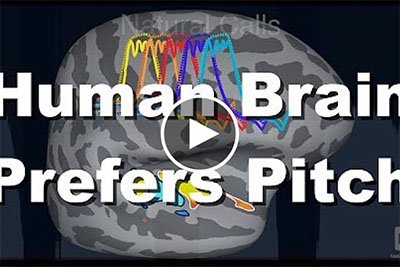Our Brains Appear Uniquely Tuned for Musical Pitch
Speech and Music May Have Shaped Human Brain Circuits for Hearing
In the eternal search for understanding what makes us human, scientists found that our brains are more sensitive to pitch, the “higher” and “lower” (or “deeper”) sounds caused by differences in wavelength (frequency), than our evolutionary relative the macaque (Macaca mulatta). The study, published in Nature Neuroscience and funded in part by NIH, highlights the promise of Sound Health, a joint project between the NIH and the John F. Kennedy Center for the Performing Arts, in association with the National Endowment for the Arts, that aims to understand the role of music in health. (See “Is Music Really the Medicine of the Soul” in this issue of the NIH Catalyst.)

CREDIT: BEVIL CONWAY LAB, NEI
Tuned for musical pitch: NIH-funded scientists found that our brains may be uniquely sensitive to the range of pitches (sound-wave frequencies) used in music and speech.
“We found that a certain region of our brains has a stronger preference for sounds with pitch than macaque monkey brains,” said the study’s senior author Bevil Conway, who was a scientist at the Massachusetts Institute of Technology (MIT) in Cambridge, Massachusetts, at the time of the study, and who joined NIH as an investigator in the National Eye Institute in 2016. “The results raise the possibility that these sounds, which are embedded in speech and music, may have shaped the basic organization of the human brain.”
The study started with a friendly bet between Conway and Sam Norman-Haignere, a postdoctoral fellow at Columbia University’s Zuckerman Institute for Mind, Brain, and Behavior (New York) and the first author of the paper.
At the time, both were working at MIT. Conway’s team had been searching for differences between how human brains and monkey brains control vision, only to discover that there are very few. Their brain-mapping studies suggested that humans and monkeys see the world in very similar ways. But then, Conway heard about some studies on hearing being done by Norman-Haignere, who was then a postdoctoral fellow in the laboratory of Josh H. McDermott, an associate professor at MIT.
“I told Bevil that we had a method for reliably identifying a region in the human brain that selectively responds to sounds with pitch,” said Norman-Haignere. That is when they got the idea to compare the brains of humans with those of monkeys. Based on what he’d learned about vision, Conway bet that they would see no differences in the way the brains responded to sound.

A brain-imaging study has found that the human brain more strongly favors harmonic tones over noise (sounds without pitch) than the macaque (Macaca mulatta) brain. The results suggest that speech and music may have shaped our brain’s hearing circuits. The two species appear to have evolved differences in the functional organization of brain regions involved in pitch perception. Bevil Conway, of the NIH Intramural Research Program, senior author on the study, explains its findings in the video. The study was published June 10, 2019, in the journal Nature Neuroscience.
To test their hypothesis, the researchers did two experiments in which they played a series of harmonic tones and noise sounds (sounds without pitch) to six healthy volunteers and five monkeys. The sounds in the first experiment were all synthesized tones (such as broadband noise or simple ring tones on a cell phone)—pitch as well as noise or pitch-less versions. In the second experiment, the sounds were macaque vocalizations and versions of the vocalizations that had been put through an algorithm to render them pitch-less (much like whispering, which preserves the frequency range and temporal structure, but lacks pitch).
Functional magnetic-resonance imaging (fMRI) was used to monitor brain activity in response to the sounds. At first glance, the fMRI scans looked similar and confirmed previous studies. Maps of the auditory cortex of human and monkey brains had similar hot spots of activity regardless of whether the sounds contained harmonic tones.
However, when the researchers looked more closely at the data, they found evidence suggesting that the human brain’s auditory cortex was much more responsive than the monkey cortex to harmonic tones.
“We found that human and monkey brains had very similar responses to sounds in any given frequency range. It’s when we added tonal structure to the sounds that some of these same regions of the human brain became more responsive,” said Conway. “These results suggest the macaque monkey may experience music and other sounds differently. In contrast, the macaque’s experience of the visual world is probably very similar to our own. It makes one wonder what kind of sounds our evolutionary ancestors experienced.”
Archaeologists find the earliest physical evidence of music—musical instruments—to date to roughly 40,000 years ago. Some scholars believe that music preceded speech. The human vocal cords appear to have achieved their current range of pitches more than 500,000 years ago.
In the second set of experiments, fMRI scans showed that the human auditory cortex, compared to the monkey cortex, was much more responsive to the natural monkey calls than the pitch-less calls.
“This finding suggests that speech and music may have fundamentally changed the way our brain processes pitch,” said Conway. “It may also help explain why it has been so hard for scientists to train monkeys to perform auditory tasks that humans find relatively effortless.”
Earlier this year, other scientists from around the United States applied for the first round of NIH Sound Health research grants. Some of these grants may eventually support scientists who plan to explore how music turns on the circuitry of the auditory cortex that make our brains sensitive to musical pitch.
This page was last updated on Monday, April 4, 2022
